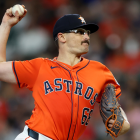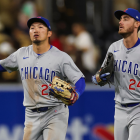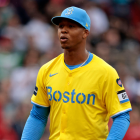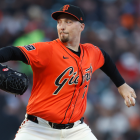
Leaderboarding: 100-mph pitches | Stranding runners | Quality starts | Hitters in 0-2 counts | RBI percentages | Taking the extra base | Looking strikeouts
Since the Eye on Baseball topic of the day is the catcher, let's devote this episode of Leaderboading to those who costume themselves in the "tools of ignorance."
Specifically, let's look at which catchers in 2013 were the best and worst at framing pitches. That is, which catchers excelled in terms of making balls look like strikes and, in a similar vein, not making strikes look like balls? The art of this, of course, is to make the umpire see taken, borderline pitches as being on the margins of the strike zone. The best catchers do this by setting up well and employing subtletly when they receive the ball and ease it back into the zone. The worst, of course, tend to stab or lunge at the ball in such a way that makes the pitch look as though it drifted off course. "Quiet hands" are the key.
This is a skill native to the catcher position that's getting more and more attention of late, but it still ranks behind, say, throwing arm, mobility behind the plate and handling pitchers when it comes to what we think about when we think about catchers.
As previously examined in this very space, Jose Molina of the Rays has established a reputation as being the very best when it comes to framing pitches. Here's a representative example of his work in this regard ...

As we said: Quiet hands make the difference.
When it comes to putting a number to a catcher's ability to frame pitches, typically PitchF/x data is used to determine how often a catcher is able to make a strike out of a ball or vice versa. There's some imprecision, to be sure, but at the extremes we get a good idea of who's adept at this sort of thing and who's not.
Thanks to the catcher data available at Matthew Carruth's StatCorner, we can see who was best and worst in 2013 according to runs saved (or squandered) versus the average catcher. So here -- again, denominated in runs above average (RAA) -- are the best of 2013 when it comes to framing pitches ...

Jonathan Lucroy tops the list, and it's not especially close. This squares with Lucroy's reputation as a skilled framer, and it's part of the reason the Brewers were eager to lock him up long-term. Throw in his solid offensive chops, and Lucroy, when healthy, stands as one of the most solidly underrated players in baseball. The Brewers also place Martin Maldonado in the top 10. Since theoretical runs of this nature tend to translate to wins at a rate of about 10 per, the Brewers added roughly more than four wins solely by virtue of their catchers' ability to frame pitches.
Also, it's not surprise to see the Molina brothers near the top, and Russell Martin's presence is in keeping with general perceptions of his value. And there's Buster Posey, proving he's more than "just" an elite hitter.
And now the bottom of the list ...

You've got some quality bats on here, but guys likes Rosario, Buck, Pierzynski and Wieters give back some of that value via their poor framing, at least in 2013. That's not to say these guys are bad defensive catchers, as there's much more to the position than framing pitches, but it does hurt their overall profile.
(Winks of CBS eye: Data: StatCorner; Graphics: Infogr.am)





















